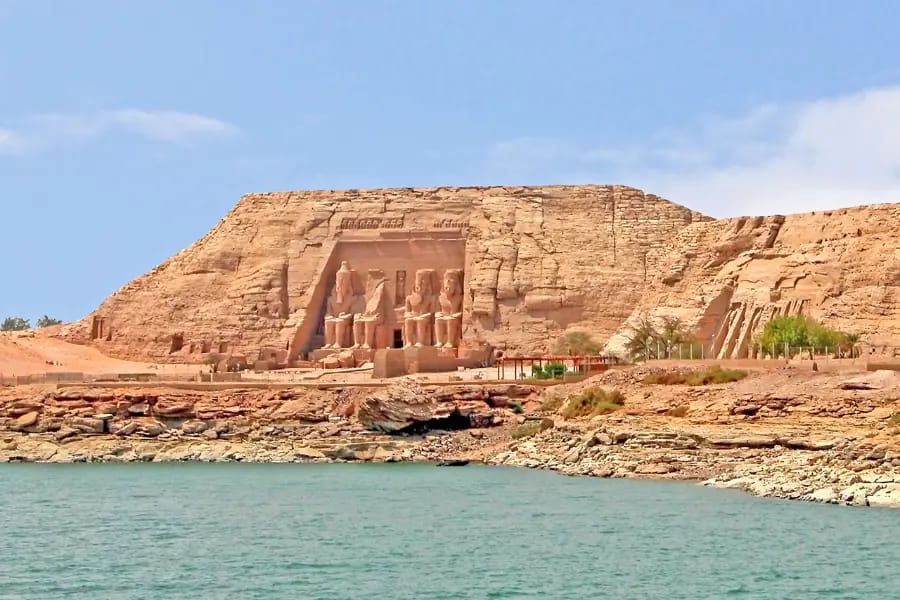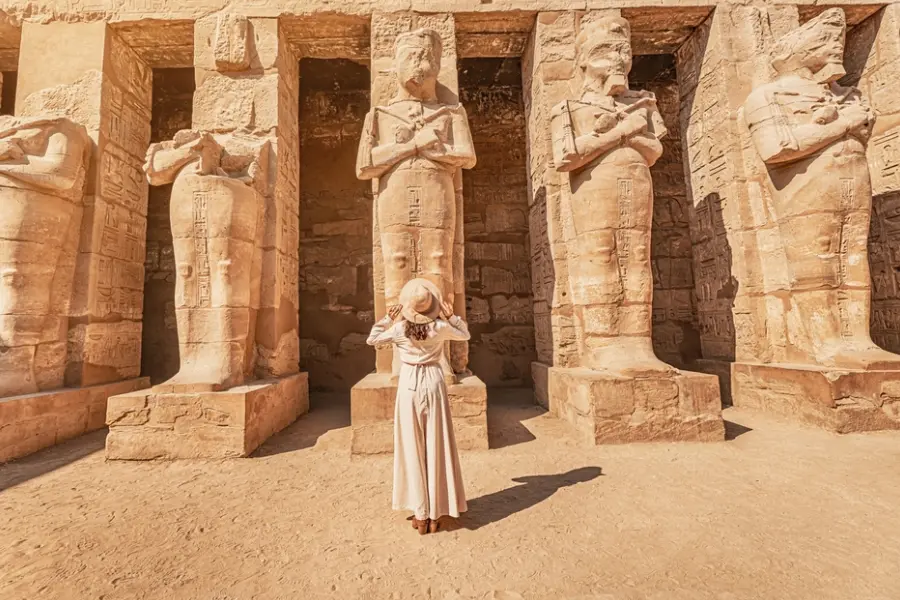The Great Pyramid of Khufu (Cheops) – Complete Guide
Step into the timeless world of ancient Egypt, where monumental structures rise from the desert sands, preserving the stories, rituals, and ambitions of one of history’s greatest civilizations. Among these wonders, none is more iconic than the Khufu Pyramid — also known as the Cheops Pyramid or the Great Pyramid of Giza.
Towering over the Giza Plateau, this awe-inspiring monument has fascinated historians, archaeologists, and travelers for centuries. In this guide, we’ll explore its origins, architecture, mysteries, and legacy — showing why the Great Pyramid remains one of the most extraordinary achievements of the ancient world.
Key Takeaways – Khufu Pyramid (Great Pyramid of Giza)
- ✅ The Khufu Pyramid, also called the Cheops Pyramid, is the largest pyramid in Egypt.
- ✅ Built during the 4th Dynasty (c. 2600 BC), it stood 146m (481 ft) tall — the tallest structure in the world.
- ✅ Known today as the Great Pyramid of Giza, it’s the last surviving Wonder of the Ancient World.
- ✅ Constructed from over 2.3 million limestone and granite blocks, weighing up to 80 tons each.
- ✅ Its precise alignment with the cardinal points remains one of archaeology’s great mysteries.
- ✅ Visitors can explore passages, the King’s Chamber, and marvel at ancient engineering genius.
What Is the Great Pyramid of Khufu?
The Great Pyramid of Khufu, also known as the Cheops Pyramid, is the largest and most famous pyramid in Egypt. Built around 2600 BCE during the Old Kingdom, it served as Pharaoh Khufu’s royal tomb and stands as the only surviving Wonder of the Ancient World.
Standing on the Giza Plateau near Cairo, the Khufu Pyramid is admired for its massive scale, precise alignment with the cardinal points, and enduring mysteries. Originally rising 146 meters (481 feet), it remained the tallest structure on Earth for nearly 3,800 years, drawing scholars and travelers alike to study its secrets.
As the monumental tomb of Pharaoh Khufu of the Fourth Dynasty, the pyramid symbolizes Egypt’s architectural genius and cultural legacy. Today, it remains one of the most visited and studied ancient monuments, inspiring awe as both a historical treasure and an engineering masterpiece.
Who Was Pharaoh Khufu?
Pharaoh Khufu, known in Greek as Cheops, was the powerful ruler of Egypt’s Fourth Dynasty. He is most famous for commissioning the Great Pyramid of Giza, the largest pyramid ever built and the only surviving Wonder of the Ancient World.
Khufu was the son of Sneferu, the founder of the dynasty, and the father of King Khafre, who built the second pyramid at Giza. His reign, from around 2589 to 2566 BCE, lasted approximately 23 years and marked a peak in pyramid construction and centralized power in ancient Egypt.
Although little is known about his daily life or politics, the scale and precision of the Great Pyramid highlight Khufu’s ambition, organizational skills, and the technological mastery of his era. Today, he remains a symbol of Egypt’s engineering brilliance and a central figure in the story of the Giza Plateau.
Who Built the Great Pyramid of Giza?
The Great Pyramid of Giza, commissioned by Pharaoh Khufu, is believed to have been designed and supervised by Hemiunu, his vizier and nephew. A skilled architect and engineer, Hemiunu organized the workforce and oversaw the project’s precise planning during Egypt’s Fourth Dynasty.
Hemiunu’s role as chief architect and vizier gave him unmatched authority in Khufu’s court. He is credited with coordinating tens of thousands of workers and employing advanced techniques that ensured the pyramid’s perfect alignment with the cardinal points and its lasting stability. His genius made the pyramid an enduring Wonder of the Ancient World.
When Was the Pyramid of Khufu Constructed?
The Pyramid of Khufu was built between 2580 and 2560 BCE, during Egypt’s Fourth Dynasty. As one of the earliest large-scale pyramid projects, its construction marked a turning point in the Old Kingdom’s engineering, mathematics, and state organization.
The project required years of meticulous planning, astronomical knowledge, and the labor of tens of thousands of skilled workers. Through immense effort and precision, Khufu’s pyramid became the tallest man-made structure in the world for more than 3,800 years — a testament to Egypt’s architectural brilliance and ambition.
Where Is the Great Pyramid Located?
The Great Pyramid of Khufu stands on the Giza Plateau, just outside Cairo on the west bank of the Nile River. Surrounded by the pyramids of Khafre and Menkaure, it forms the iconic Giza complex, alongside the Great Sphinx of Giza.
This elevated desert setting provided ancient Egyptians with breathtaking views and an ideal site to align monuments with celestial bodies. Its location also emphasized the pyramid’s symbolic role as a bridge between the Earth, the Nile, and the heavens.
How Tall Is the Great Pyramid of Giza?
Originally rising to 481 feet (147 m), the Great Pyramid of Khufu was the tallest man-made structure in the world for nearly 3,800 years. Today, after erosion and the loss of casing stones, it stands at about 455 feet (138.8 m).
- Original height: 481 ft (147 m).
- Current height: 455 ft (138.8 m).
- Held world record for tallest structure for 3,800 years.
The precision of its design continues to impress modern architects and symbolizes the advanced engineering of ancient Egypt.
How Was the Pyramid of Khufu Built?
The Great Pyramid of Khufu was built with over 2.3 million limestone and granite blocks, weighing between 2 and 15 tons each. Its construction remains one of history’s greatest engineering feats.
The stones were quarried locally and transported using sledges, wooden rollers, ramps, and possibly early pulley systems. Scholars debate the exact techniques, but the project required exceptional planning, vast manpower, and ingenuity.
- ✅ Over 2.3 million blocks used.
- ✅ Each block weighed 2–15 tons.
- ✅ Built with ramps, sledges, and precise alignment.
Its scale and enduring stability still inspire engineers, historians, and travelers worldwide.
What’s Inside the Pyramid of Khufu?
Inside the Great Pyramid of Khufu lies a network of chambers and passageways designed with astonishing precision. The inner layout includes the King’s Chamber, Queen’s Chamber, a subterranean chamber, and the dramatic Grand Gallery, each serving symbolic, architectural, and ritual purposes.
- King’s Chamber: granite-built room containing a massive sarcophagus.
- Queen’s Chamber: likely symbolic, not actually for a queen.
- Subterranean chamber: unfinished, carved into bedrock below.
- Grand Gallery: steep, high passageway connecting chambers.
- Shafts: once thought ventilation, now believed to be astronomical alignments.
Recent scans using muon detection revealed possible hidden voids above the Grand Gallery, suggesting that mysteries still remain inside Khufu’s pyramid. This has sparked modern explorations using robotic probes and advanced imaging technology.
Why Is the Great Pyramid of Khufu Important?
The Great Pyramid of Giza is important for its role as Pharaoh Khufu’s tomb, its alignment with celestial bodies, and its unmatched scale. It represents Egypt’s belief in the afterlife, Khufu’s divine authority, and the pinnacle of ancient engineering.
Beyond its spiritual symbolism, the pyramid showcases remarkable engineering and state organization. Built over 4,500 years ago without modern tools, it stood as the world’s tallest structure for nearly 4,000 years and remains the last of the Seven Wonders of the Ancient World.
- ✅ Tomb of Pharaoh Khufu, symbol of divine kingship.
- ✅ Precise alignment with stars and cardinal points.
- ✅ Global icon of human ambition and engineering skill.
- ✅ Only surviving Wonder of the Ancient World.
Today, it continues to inspire visitors, scholars, and engineers worldwide, symbolizing both Egypt’s ancient power and humanity’s enduring quest to achieve the impossible.
How Did the Cheops Pyramid Align with Celestial Bodies?
The Cheops Pyramid is renowned for its precise astronomical alignment. Each side faces a cardinal direction—north, south, east, west—with an error margin of less than 0.05°. This accuracy highlights the Egyptians’ advanced knowledge of the stars and their spiritual link between Earth and the heavens.
Researchers suggest that its orientation may have been used to observe solar and stellar events, reinforcing its role as both a tomb and a cosmic gateway. Modern surveys confirm that the pyramid’s near-perfect alignment still stands as one of the greatest engineering and symbolic feats of the ancient world.
Was Any Treasure Found Inside the Pyramid?
Surprisingly, no treasures were discovered inside the Great Pyramid of Khufu. When first explored, its burial chamber was found empty, containing only a large granite sarcophagus believed to have once held Khufu’s remains.
Archaeologists believe valuable goods were looted in antiquity, perhaps during the First Intermediate Period. Yet the pyramid itself is often called Egypt’s greatest treasure, a monument that embodies engineering genius, spiritual meaning, and enduring historical value.
What Was the Pyramid’s Role in Khufu’s Funerary Complex?
The Khufu Pyramid was the central monument of Pharaoh Khufu’s vast funerary complex. Designed as a sacred landscape, it supported the king’s journey to the afterlife, combining religious, ceremonial, and symbolic structures around the pyramid.
- 🔹 Mortuary temple: priests performed daily rituals to honor Khufu.
- 🔹 Valley temple: connected by a causeway, used in funerary processions.
- 🔹 Subsidiary pyramids: built for queens near the main pyramid.
- 🔹 Mastaba tombs: burial places for nobles and high officials.
- 🔹 Boat pits: housed solar barques for Khufu’s journey in the afterlife.
Together, these elements created one of the most complete mortuary complexes in ancient Egypt, reflecting Khufu’s power, the state’s organization, and deep beliefs about eternity and cosmic order.
How Was the Great Pyramid of Khufu Built: The Full Story
The Great Pyramid of Khufu was built during Egypt’s Fourth Dynasty around 2589–2560 BCE. Its construction is a story of ambition, innovation, and endurance, involving tens of thousands of workers, advanced planning, and remarkable engineering that created the largest pyramid ever built in ancient Egypt.
Planning the Pyramid: Vision and Workforce
Khufu appointed skilled architects, engineers, and artisans to design his monument. Estimates suggest 20,000–30,000 laborers worked in rotating crews, supported by seasonal farmers, craftsmen, and administrators. This organized workforce ensured precision despite the harsh desert conditions.
Sourcing the Stone and Preparing the Site
Most limestone came from quarries near the Giza Plateau, while granite for the King’s Chamber was transported over 800 km from Aswan. Blocks weighing 2.5–15 tons were cut with copper chisels and dolerite pounders, shipped via the Nile, then hauled on sledges across prepared causeways to the building site.
Construction Techniques and Pyramid Design
The pyramid’s base measured about 230 m (756 ft) per side, leveled with astonishing accuracy. Stones were laid in horizontal courses, stacked with millimeter precision. Scholars debate whether massive external ramps or internal spiral ramps were used to lift the blocks. Inside, builders created the King’s Chamber, Queen’s Chamber, Grand Gallery, and intricate passageways.
- Base: 230 m per side, perfectly aligned to cardinal points.
- Height: 147 m (481 ft) at completion.
- Internal chambers reflected beliefs in resurrection and afterlife.
Completion and Legacy
The pyramid took about 20 years to complete, finishing around 2560 BCE. For nearly 4,000 years, it remained the tallest man-made structure in the world. Today, the Pyramid of Khufu continues to inspire awe, symbolizing ancient Egyptian innovation, spiritual devotion, and Khufu’s enduring quest for immortality.
Myths & Theories about the Great Pyramid of Khufu
The Khufu Pyramid has inspired countless myths and alternative theories. While Egyptologists agree it was a royal tomb built with advanced planning, several ideas continue to fascinate researchers and visitors alike.
- Ramp Theories: Straight, zig-zag, or circular ramps are believed to have been used to transport massive blocks into position.
- Lost Technology: Some suggest ancient builders possessed techniques now forgotten, making the pyramid’s precision seem impossible.
- Astronomical Alignment: The Great Pyramid is aligned within 0.05° of true north and possibly linked to Orion’s Belt stars.
- Alien Theories: Fringe theories claim extraterrestrial help, though no scientific evidence supports this idea.
These theories highlight the pyramid’s enduring mystery and why it continues to capture the world’s imagination.
Visitor Tips: How to See Khufu Pyramid Today
Visiting the Great Pyramid of Khufu is an unforgettable experience. To make the most of your trip, prepare ahead with practical tips on tickets, dress, hydration, and safety. These guidelines ensure a smooth visit while respecting and preserving one of the world’s most iconic monuments.
1. Plan Ahead for a Smooth Visit
Check opening hours, ticket prices, and visitor guidelines before you go. The site gets crowded, especially in peak season, so booking tickets or guided tours in advance is highly recommended.
2. Dress Comfortably and Appropriately
The Giza Plateau is hot and exposed. Wear breathable clothing and comfortable shoes, especially if entering the pyramid. Don’t forget a hat, sunglasses, and sunscreen. Learn More about what to wear in Egypt.
3. Stay Hydrated
Bring a reusable water bottle and drink often. Light snacks are useful if you plan to spend the day exploring.
4. Respect Local Culture and Customs
Dress modestly, avoid climbing or touching the stones, and be respectful in interactions. The pyramids are protected heritage sites.
5. Hire a Knowledgeable Guide
A licensed Egyptologist guide can enrich your visit with history, context, and stories you won’t find in books.
6. Arrive Early
Beat the heat and crowds by arriving close to opening time. Early morning also offers the best light for photography.
7. Be Prepared for the Interior Climb
Inside the pyramid, expect narrow passages, steep inclines, and limited airflow. Entry requires a separate ticket and may be strenuous.
8. Follow Photography Rules
Photography is allowed, but flash may be restricted. Always follow the site’s policies and respect no-photo zones.
9. Help Preserve the Site
Stay on marked paths, don’t litter, and never scratch or mark the stones. These actions help protect the pyramid for the future.
10. Embrace the Experience
Pause and reflect on the scale and beauty of Khufu’s pyramid. It’s more than a monument — it’s a window into ancient Egyptian civilization and a symbol of human achievement.
Khufu Pyramid Tickets, Hours & Best Time to Visit
Planning your visit to the Great Pyramid of Khufu? Here are the practical details you need to know about opening hours, ticket prices, and the best time for a smooth trip.
Opening Hours
- Daily: 7:00 AM – 5:00 PM
- Last entry usually around 4:00 PM
Ticket Prices
- Giza Plateau General Entry: 700 EGP (adults), 350 EGP (students)
- Inside Khufu Pyramid: 1,500 EGP (separate ticket)
- Egyptian & Arab visitors: 100 EGP (adults), 50 EGP (students)
Best Time to Visit
- Early morning (close to opening) to avoid heat and crowds.
- Morning light offers the best photography conditions.
- Cooler months (October to April) are more comfortable for exploring.
Keep in mind that ticket prices and opening times may change, so it’s best to confirm on the day of your visit. Arriving early ensures a calmer and more memorable experience at the Great Pyramid of Giza.
Interesting Facts about the Great Pyramid of Khufu
- Built with more than 2.3 million limestone and granite blocks.
- Original height: 147 m (481 ft); current height: ~138 m (455 ft).
- Last surviving Wonder of the Ancient World.
- Aligned precisely with the cardinal directions within 0.05°.
- Estimated to have taken 20–30 years to build.
- Latest scans revealed hidden voids inside (2017 muon research).
- The base covers an area equal to about 13 acres.
Comparison of the Pyramids of Giza
The Giza Plateau hosts three main pyramids, each built by a different pharaoh. Here’s how the Khufu Pyramid compares to the others:
| Pyramid | Pharaoh | Original Height | Current Height |
|---|---|---|---|
| Great Pyramid of Khufu | Khufu (Cheops) | 147 m (481 ft) | 138 m (455 ft) |
| Pyramid of Khafre | Khafre | 143 m (471 ft) | 136 m (446 ft) |
| Pyramid of Menkaure | Menkaure | 65 m (213 ft) | 61 m (200 ft) |
Together, these three pyramids form the iconic Giza Plateau, showcasing the grandeur of Egypt’s Old Kingdom.
How to Visit Khufu Pyramid: Plan Your Trip with Ease
If you’re inspired to see the Khufu Pyramid up close, visiting the Giza Pyramids complex is one of Egypt’s most rewarding experiences. Whether you stay in Cairo or arrive via cruise at Alexandria or Sokhna port, planning your visit is straightforward with expert guidance.
For a smooth and enriching trip, consider booking a guided tour that includes the Great Pyramid of Giza, the Sphinx, and nearby sites like Saqqara. Egypt Tours Group offers tailored experiences designed to suit all schedules and interests:
- Private Cairo Day Tours
- Multi-day packages covering Cairo, Luxor, and Nile Cruises
- Shore excursions from Safaga, Alexandria, Port Said, and Sokhna
Conclusion
The Khufu Pyramid — also known as the Cheops Pyramid or the Great Pyramid of Giza — remains one of the most awe-inspiring monuments ever built. Constructed during the reign of Pharaoh Khufu in the Fourth Dynasty, it is the largest pyramid on the Giza Plateau and a timeless symbol of Egypt’s vision, precision, and power.
Its construction required skilled labor, meticulous planning, and unmatched determination, resulting in a structure that has stood for more than 4,500 years. From its precise astronomical alignment to the complexity of its internal chambers, the pyramid reflects the scientific and spiritual knowledge of ancient Egypt.
More than just a tomb, the Great Pyramid of Khufu is a masterpiece of human ingenuity and a reminder of Egypt’s enduring legacy. As research continues, it remains a source of fascination and inspiration — a true Wonder of the Ancient World.
Quick Facts about the Khufu Pyramid
| Feature | Detail |
|---|---|
| Pharaoh | Khufu (4th Dynasty) |
| Construction | c. 2589–2566 BCE |
| Original Height | 147 m (481 ft) |
| Current Height | 138 m (455 ft) |
| Blocks | ~2.3 million limestone & granite |
| Location | Giza Plateau, near Cairo |
FAQs – Khufu Pyramid
Why was the Khufu Pyramid built?
The Great Pyramid of Khufu was constructed as a royal tomb, ensuring Pharaoh Khufu’s passage to the afterlife and symbolizing his divine authority during Egypt’s Fourth Dynasty.
How many blocks are in the Great Pyramid of khufu?
The pyramid is made of about 2.3 million stone blocks, weighing between 2 and 15 tons each, transported from nearby quarries.
Can visitors go inside the Pyramid of Khufu?
Yes, entry is possible with a separate ticket. Visitors can access narrow passages, the Grand Gallery, and the King’s Chamber, though space is limited.
How long did it take to build Khufu pyramid?
Historians estimate it took between 20 and 30 years, involving tens of thousands of skilled workers and laborers under the supervision of Hemiunu.
Were any treasures found inside Cheops Pyramid?
No treasures were discovered, likely due to looting in antiquity. The only major artifact remaining is the large granite sarcophagus in the King’s Chamber.
















